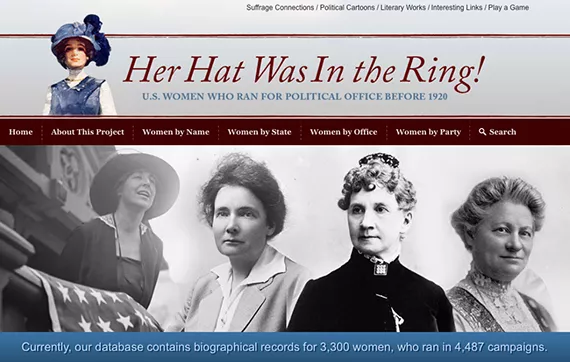Curator Wendy Chmielewski Shows Women Were Elected Before They Could Vote

Slate: Thousands of Women Ran for Office Before They Could Vote
Olive Rose was elected to the office of Register of Deeds in Lincoln County, Maine, in 1853. In the Annals of the town of Warren, Maine, her election rated a ceremonial mention: “On the 30th of May, the town showed its regard for female rights, in respect to holding office, by giving Miss Olive Rose 73 votes for County Register of Deeds.”
Rose may be the first member of a largely forgotten historical group: the thousands of women who ran for local, state, and national offices before the ratification of the 19th Amendment in 1920 granted women the universal right to vote.
Jill Norgren and Wendy Chmielewski, co-founders of the site Her Hat Was in the Ring, have been searching for historical traces of these candidates for the past seven years, adding their stories into an ever-expanding database of biographies of women candidates. As the Hillary Clinton presidential campaign kicks off, this longer history shows that American women have been running for—and winning!—offices big and small for more than 150 years.
The Her Hat project challenges historians’ long-held ideas about the way women participated in political life before they won the universal right to vote. The conventional wisdom is that late 19th- and early 20th-century women, barred from full citizenship, threw themselves into informal community activism, in particular by joining reform groups and women’s clubs.
...
Norgren, a professor emeritus who taught government and women’s studies at John Jay College and the CUNY Graduate Center, and Chmielewski, the George Cooley Curator of the Swarthmore College Peace Collection, met in 2007 when Norgren visited the archive to research her biography of pioneering female presidential candidate Belva Lockwood.
“As Hillary Clinton began her primary campaign that year, Wendy and I began throwing around the question: Exactly how many women besides Lockwood did run for office before universal suffrage?” Norgren told me. “In informal conversations, we were looking at each other and saying ‘What could it be? 75 people?’ That seemed like an enormous number.”
The website—designed by Kristen Gwinn-Becker, the project’s third collaborator, a Ph.D. in women’s history who runs the consulting firm History IT—now holds biographical information for 3,289 women candidates, and the researchers have as-yet-unprocessed data for about 1,800 more. The total number of campaigns in the database is 4,480; in a startling 3,339 of those campaigns, women candidates were successful. (Female candidates lost 730 campaigns; for 411 of the contests, the outcome is unknown.)
...
Despite the work yet to be done, the data that Norgren and Chmielewski have collected shows that women, while certainly marginalized in the time before suffrage, affected the course of public life in hundreds of communities in the late 19th and early 20th centuries. Chmielewski argues that the traditional characterization of the nature of American women’s citizenship before suffrage—that they were partial or incomplete citizens, obligated to their husbands and not to the state—is complicated by the thousands of counterexamples of women who served in elected office. Chmielewski also pointed out that if the researchers had included women who were appointed to office, or held civil service positions, the number of those who had served before suffrage would have been much bigger. “We would have been at about 50,000 women,” she said.
That’s a lot of women making decisions before they were trusted with the vote.
Read the full article at Slate.
Chmielewski is an authority on social and peace movements in the United States with particular expertise in women in intentional communities, women's history, and women and the peace movement through the 19th and 20th centuries.
An exhibit, "Her Hat Was in the Ring: U.S. Women Campaigning for Political Office, 1850-2016" will be on view next semester in McCabe Library from Jan. 19th until Feb. 29 and will feature material from the private collection of campaign memorabilia, photographs, postcards, ballots, books, and other items that Chmielewski and Norgren have gathered, much of it from the 19th and early 20th centuries. Other items in the exhibit will come from Swarthmore Special Collections, the Peace Collection, and Friends Historical Library.



